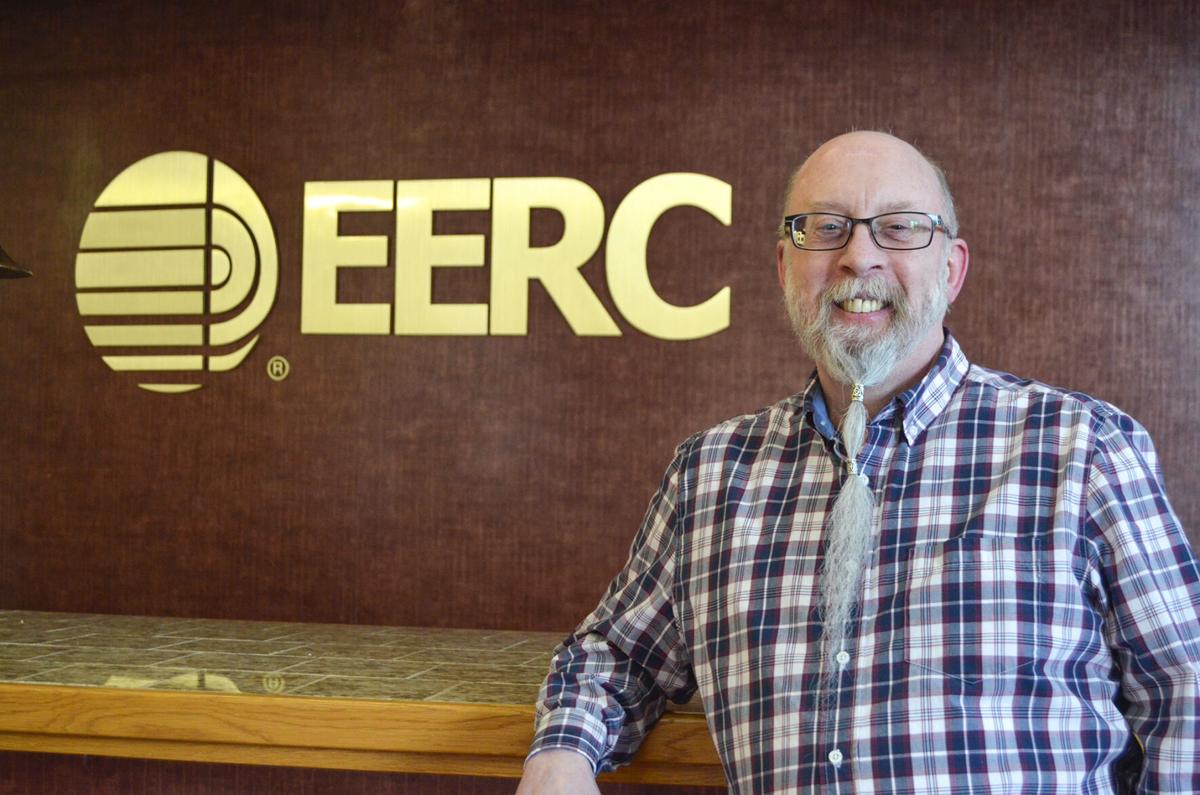Researchers Dig Deep Into North Dakota's Coal Seams For Rare Earth Elements

June 18, 2022 - Within North Dakota’s lignite coal seams lie a number of materials needed to produce touch screens used on cellphones, guidance systems for missiles, and motors and batteries for hybrid vehicles.
Researchers know that rare earth elements such as neodymium and lanthanum exist in the state’s coal, but they want to figure out whether it is feasible to put them to use.
“A lot of these materials are more abundant on earth than gold,” said John Kay, an engineer with the Energy & Environmental Research Center at the University of North Dakota in Grand Forks. “What makes them rare is wherever you find them, they are not in very high concentration. It makes it difficult to extract them in any quantity.”

John Kay heads up the CORE-CM project at the University of North Dakota's Energy & Environmental Research Center in Grand Forks.
Photo: Amy R. Sisk, Tribune
Kay heads a group of 20 people at the EERC who will work for the next year to gauge the potential for an industry surrounding rare earth elements, critical minerals and carbon ore in North Dakota. Rare earth and critical elements exist on the periodic table and are associated with organic structures left over from plants that, over the course of millions of years, have decomposed to form coal.
Many who work in coal are eager to learn their findings. Several coal mining companies and operators of coal-fired power plants have chipped in money to support the $2.45 million project, which has received a $1.1 million award from the U.S. Department of Energy and a $750,000 grant through the North Dakota Industrial Commission.
The head of research for the group lobbying for the state's coal industry is hopeful the EERC’s work, coupled with other projects in the state, will show that North Dakota has the components necessary to put the state’s coal to greater use.
“You can extract and process rare earth elements from North Dakota sources like lignite. You can also look for opportunities to start industries to make some of the products that require rare earth elements,” said Mike Holmes, vice president of research and development for the Lignite Energy Council.
Beyond Fuel
When many people hear the word coal, they “think you’re talking about a fuel, but we’re trying to move beyond that,” Kay said.
There are multiple reasons why. The coal industry faces economic challenges from natural gas and renewable power. Advocates say the production of critical minerals and rare earth elements could help maintain and create coal-related jobs. The federal government, meanwhile, wants to develop domestic sources of the minerals, which are in high demand by the electronics, defense and automobile industries, among others.
Most of the world’s supply of rare earth elements comes from China, which also manufactures products that make use of the materials. Over the past 13 years, China has enacted production and export quotas and at times halted exports to certain countries or threatened to cut off supplies in response to geopolitical incidents, according to a report published by the North Dakota Geological Survey earlier this year.
One of the factors that will determine the feasibility of producing the elements in North Dakota is whether prices remain high for the materials, the report says.
“Perhaps the least predictable variables are the future market prices for each of the critical mineral commodities, which normally fluctuate according to supply and demand,” it says. “The ever-increasing speed of technological innovation creates difficult-to-forecast new and shifting applications for many mineral commodities.”
Digging In
Several entities in North Dakota have dug into the topic in recent years, including the Geological Survey, which has been collecting samples of lignite across western North Dakota since 2015 to examine for rare earth and critical elements.
Much of that work has involved collecting samples from southwestern North Dakota where lignite with high concentrations of uranium was mined in the 1950s and 1960s. Other UND research has focused on active coal mines, which exist northwest of Bismarck near communities such as Underwood and Beulah.
The types of rare earth and critical elements differ from mine to mine, according to Kay.
“Even within a mine it will sometimes vary foot to foot,” he said.
The Geological Survey report concludes that “some North Dakota lignites contain high to extremely high concentrations of elements that are considered highly promising or are already economically produced from coal: the rare earths, molybdenum, uranium, magnesium, zirconium, vanadium and gallium.” Still, “Only a small portion of North Dakota lignites have been investigated, and the statistical likelihood is that the most enriched or thickest bed of enriched lignite remains undiscovered.”
Holmes said it would be ideal to produce the elements from coal at an existing mine to take advantage of “synergies and spend less money extracting.”
But a new site isn’t out of the question, if the materials were abundant there and the economics panned out.
Once mined, coal would need to be processed with chemicals to extract the rare earth and critical elements, likely with a liquid solution. Then those elements would need to be separated from the solution before they could be used to manufacture a product.
“It’s not like what you see in the movies where they’re digging up gold and they’re finding nuggets,” Kay said. “We’re not finding nuggets. We’re not finding flakes. We have to actually chemically extract it.”
Work Underway
Twelve other teams like the one at EERC have assembled across the United States with federal funding assistance to evaluate the potential for critical minerals and rare earth elements in their regions.
“Along the way, I would expect across the United States we are going to find areas that are going to work very well for this and there are going to be areas that show potential down the road when technology improves, but maybe aren’t ready yet,” Kay said.
While much of the work in North Dakota so far has focused on lignite coal, researchers are tasked with evaluating the potential in all energy waste streams. In North Dakota, that means researchers could look at saltwater, a byproduct of oil production, as well as coal ash.
The EERC crew is focused on the Williston Basin, an energy-rich area that extends from western North Dakota into Montana and South Dakota.
Various teams within the EERC have taken on different tasks -- everything from examining what knowledge gaps exist, to which waste streams to evaluate, to where processing and manufacturing should take place.
“As a state, we would love to do everything right here,” Kay said, explaining that the more work that can be done in North Dakota, the more it benefits the economy and encourages training for high-skilled labor within the state.
Once the EERC’s initial research wraps up in a year, the state could seek to pursue additional work supported by the Energy Department and, ultimately, begin extracting the elements for production.
But the researchers have much to learn first if they are to accomplish all that.
“There’s a lot of technology that still has to be developed to be able to do this effectively,” Kay said. “We’re right on the front edge of making this happen.”

